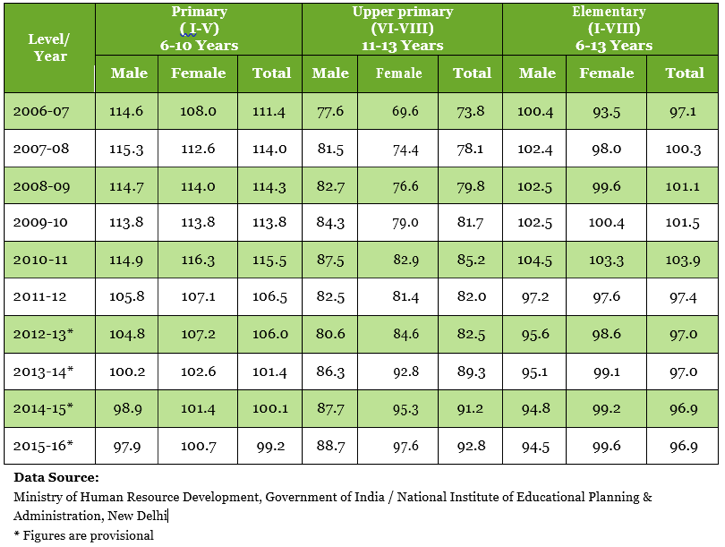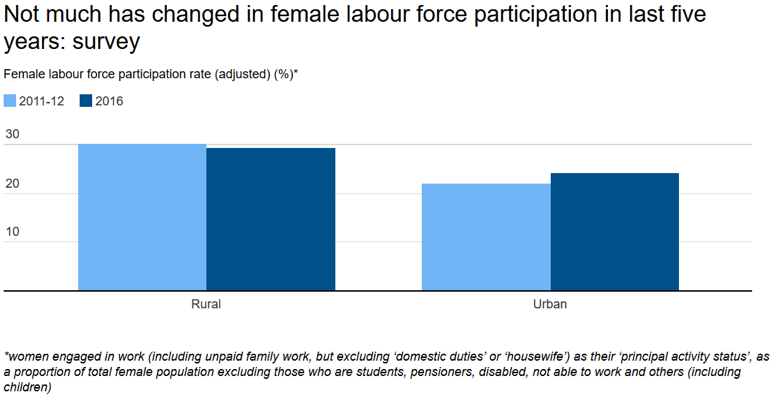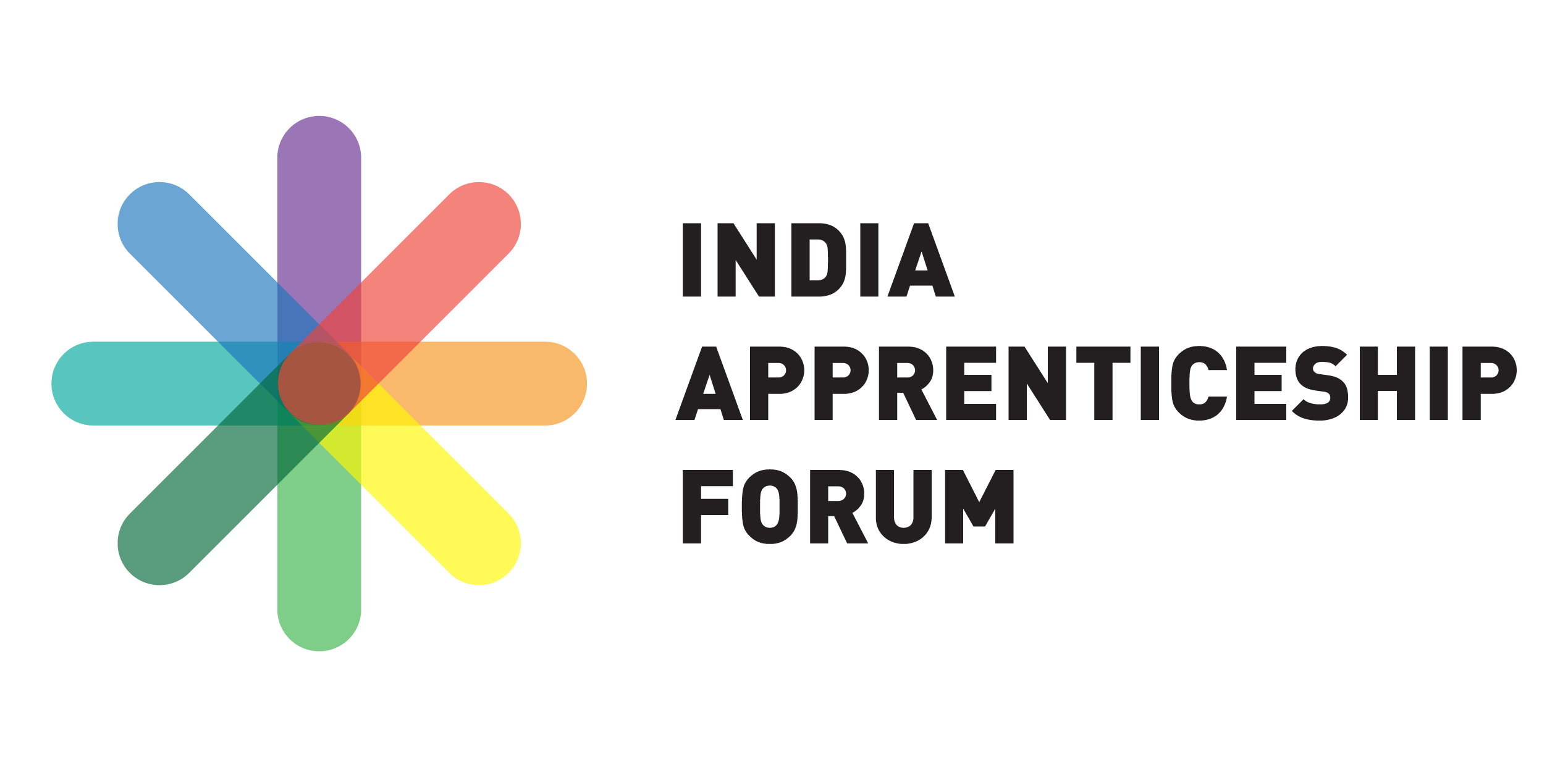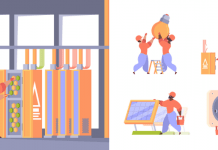In a country where many skills have societal gender-based labels, how do Indian women fare when it comes to access to skill training and vocational education?
India is ranked 121st out of 131 countries in Female Labour Force Participation (FLFP) by a 2017 World Bank Report.[i] The economic loss due to the under-representation of women in the workforce is staggering. A McKinsey Global study in 2015 found that India could increase its GDP by 16-60% by 2025 if only women were given equal employment opportunities [ii] on par with their male counterparts.
The Indian Working Woman’s Landscape
Only 28.5% of women made up the labor force in 2017 as against 82% of men.[ii] Women in India contribute just 18% to GDP whereas in China women contribute 41% to overall GDP and comprise 44% of the workforce.[iii]
Employment statistics from the last few years for Labour Force Participation Rate (LFPR) for women aged 15 and over also show a consistent trend; women made up around 25% of the total LFPR in the period between 2011-2014, dipping to 23.7% in 2015-16. Unemployment rate of women has risen from 6.9 % in 20211-12 to 8.7% in 2015-16, as against 2.9% and 4% for men in the same periods.[iv]
The annual Employment Review by the Directorate GeneraI of Employment found that in 2012, total employment in the organised sector was 295.79 lakh of which 60.54 (20.5%) lakh women were employed in the organised sector (public and private). Of this, 0.94 lakh women were employed in whole sale and retail trade and restaurants & hotels during 2011-12. iv
To provide a snapshot of women in the unorganised sector, of 149.8 million women workers in 2011 (census, 2011) 35.9 million women were working as cultivators and another 61.5 million as agricultural labourers. Of the remaining, 8.5 million were working as domestic help and 43.7 million were classified as other workers.iv
The share of women in services and industry is less than 20%.[v]
Education and the Girl Child
According to educational statistics published this year (2018) by the MHRD’s Department of School Education & Literacy, laudable progress has been achieved in girls’ enrollment in elementary and secondary education in India.


Similarly, The Annual Status of Education Report (ASER) 2017-Beyond Basics, conducted a survey of 14-18 year olds in 26 rural districts across 24 states. 86% of youth in this age group were enrolled in a school or college with no significant difference between boys’ and girls’ enrolment at age 14.
Rising Education Enrolment- Falling Workforce Participation by Women- What’s Going On
It should come as a surprise and cause for alarm that despite India’s economic stride and higher enrolment of girls in education the percentage of women withdrawing from the labour market has been rising compared to a decade ago when 43% of married women in the age group of 15-49 years had reported working in the past year in 2005-06; this number dropped to 31% in the latest 2015-16 survey conducted by National Family Health Survey (NFHS). Higher education enrolment figures are not translating into an increase in women in the workforce which begs the question why.


The reasons for the decline in women in India’s workforce continue to be a complex mix of age-old stereotypes and new economic changes. Especially in trades requiring specialised skills, there exist typical ‘male roles’ which automatically eliminate women. Besides, rising income of men have pressurised women to continue as home-makers depriving them of income-generating skills and activities. There is also the not so new issue of lack of quality jobs for women as again the majority of skills based jobs are taken up by men. The National Sample Survey Office (NSSO) further attests this unfortunate trend. Case in point, the urban male population made up 16% of India’s total population in 2011-12 but held 77% of all jobs in computer-related activities.
A vast majority of uneducated and economically backward women make up the female workforce in India. Women in agricultural, seasonal or manual jobs have little or no skill training. Providing access to skill-based training to this set of the population is where the challenges and the opportunities exist. The significance of vocational training in such a scenario is seen in a 2017[vi] study where skills-based training (formal or informal) correlated with a higher likelihood of women joining the workforce regardless of educational levels.vii
Speaking of the stark need to include more women in skill-based training, Rajesh Agarwal, Joint Secretary and CVO at Ministry of Skill Development and Entrepreneurship (MSDE) said, “India can increase its GDP by 16% if it achieves gender parity in its workforce. There is a need to make a conscious effort to address women issues and Ministry of Skill Development and Entrepreneurship is mindful of this fact.”
Policy Enablers
Women’s Vocational Training Programme under @MSDESkillIndia provides skill training to women through a network of Industrial Training Institutes (ITIs). Approved training programmes impart skills to women under various schemes such as Craftsmen Training Scheme across trades such as electronics, mechanics, architectural draughtsmanship, computer operator and programming assistant, secretarial practice, cosmetology, dress making, catering & hospitality, interior designing, amongst others. To attract women from economically backward backgrounds these schemes also offer merit and/or means-based stipends and accommodation. Currently, there are 19 National Skill Training Institutes which run women-focused vocational training. A total of 4664 seats have been sanctioned for women in 2017-18, and overall 1,45,000 women have been trained by these institutes.
Echoing the importance of such schemes Rajesh Agarwal, Joint Secretary and CVO at @MSDESkillIndia highlighted pan India government training initiatives for women. “As per the information furnished by the respective State Governments, there are about 405 Women ITIs and 1003 Women Wings in general ITIs/ITCs having a total of 83,270 training seats as on Jun, 2017,” he said. “Last year, we have had around 1.34 lakh women train from our ITIs. There are great examples of women who have also been trained in hard skills like welding etc. We are also focusing on promoting skill development in local trades, art and culture where more rural women can participate and will not have to migrate,” he added.
Furthermore, under the government’s efforts to vocationalise secondary and tertiary education, one of the provisions of the National Vocational Education Qualification Framework (NVEQF) is a proposal for a one-off financial assistance for the construction of women’s hostel in 500 polytechnics as a way to attract more women to enroll in such education. Another provision is the Jan Shikshan Sansthan expected to prioritise vocational training needs of illiterate and semi-literate women in urban and rural India. 17 trades have been approved as of 2016-17 under vocationalisation of education, such as retail, beauty & wellness, tourism, gems & jewelry keeping in mind interests of the girl child.[vii]
Conclusion
Apprenticeships and other vocational training in India do not reach the majority of women from rural and semi-rural areas at the required spread or pace forcing them to work as unskilled labour in the unorganised sector. Additionally, women need to be encouraged to consider atypical skills and not limit themselves due to gender stereotypes. At the same time, without having to re-invent the wheel, the quality of training for traditionally women friendly skill based roles needs to improve so they are at par with trades dominated by men in terms of wages and perceived value. If more Indian women joining the workforce has the potential to add $770 billion to India’s GDP by 2025,ii it goes without saying that women in India are a severely untapped economic resource and to close the asymmetry in the labour market a fundamental shift needs to take place in the national context.
References
i. Precarious Drop Reassessing Patterns of Female Labor Force Participation in India, Apr 2017
ii World Economic Forum, The Global Gender Gap Report 2017
iii. Annual Report 2017-18, Ministry of Labour & Employment
iv. India Development Report‘ World Bank, May 29, 2017
v. Women and Work in India: Descriptive Evidence and a Review of Potential Policies, Dec 30, 2017
vi. Annual Report 2016-17, Department of School Education & Literacy, Department of Higher Education, MoHRD














